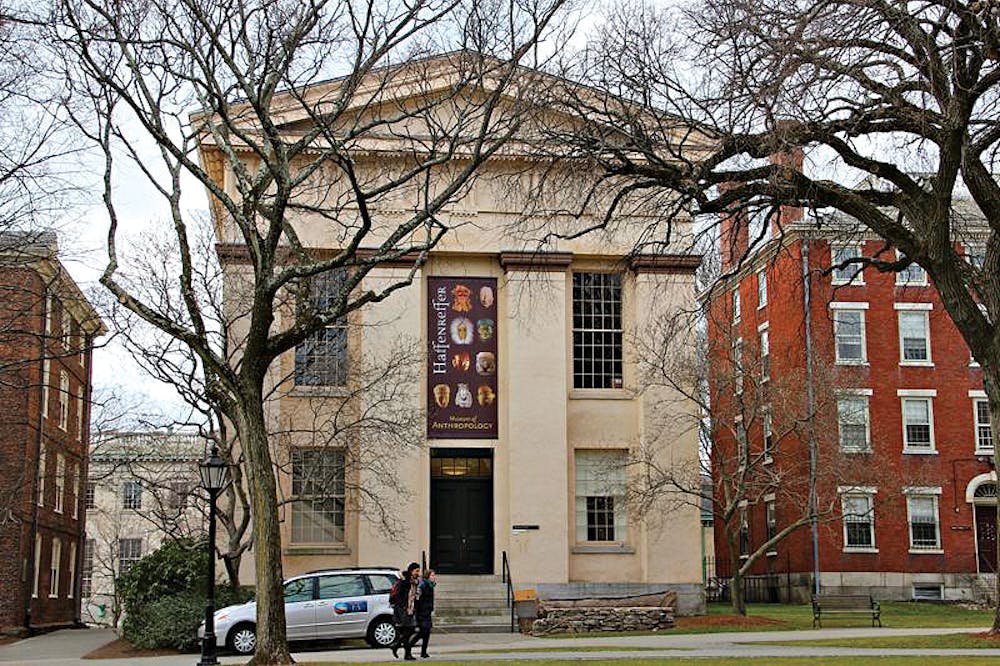An Ukhurhe, a rattle staff used in ancestral ceremonies, is one of 15 objects crafted in Benin City, now southern Nigeria, that lie in the collections of the Haffenreffer Museum of Anthropology.
Artifacts from Benin are tied to a violent history — in 1897, British colonial forces ravaged the Royal Palace in Benin City, plundering thousands of artworks in the massacre.
The Haffenreffer Museum has established a partnership with the Digital Benin Initiative, an international project aiming to catalogue the dispersed royal artworks looted from Benin. The collaboration marks the beginning of the process to determine the 15 artifacts’ specific origins, opening the possibility of repatriation — the return of the objects to Benin.

The Haffenreffer is in the “very early stages” of its partnership with the initiative, wrote Robert Preucel, director of the Haffenreffer and James Manning professor of anthropology, in an email to The Herald. The museum “jumped at the chance to collaborate” with the initiative after being contacted in April, he wrote.
If the provenances — the earliest known history of the artifacts — are found to have a clear indication of looting, “the museum would certainly consider returning any of the objects,” Preucel wrote. Repatriation would mean the first transfer of the objects since they were donated to the museum around 50 years ago.
Critical discourse on the housing of Benin objects in museums gained traction with the publication of the 2018 Sarr-Savoy report, which detailed the history of African objects during the French colonial period and recommended procedures for the restitution of plundered art.
Preucel cited the Sarr-Savoy Report as a motivator in joining the initiative. The report illustrates that “unless African youth travel abroad, they do not have an opportunity to see and engage with some of the most remarkable examples of their own art, history and culture,” he wrote.
Along with uncovering the provenances of the Benin artifacts, the Digital Benin Initiative provides the Haffenreffer Museum a channel of communication with the Benin Dialogue Group, which includes the Royal Court of Benin, the Edo State Government and the National Commission for Museums and Monuments in Nigeria, according to Preucel.
The museum favored the Digital Benin Initiative for its involvement with “not just the museums, but the people of origin as a stakeholder,” said Thierry Gentis, curator for the Haffenreffer and Native American Graves Protection and Repatriation Act Coordinator. “They will be best suited to tell us how to deal with these materials … and we hope this will help them regain some of their culture and heritage,” he added.
The original 2022 end date for the museum’s project with the Digital Benin Initiative will be extended into 2023 due to slowdowns from the pandemic, according to Gentis. A priority for the museum is to complete photographing the objects from Benin and making the photographs available to the initiative. By next year, the museum expects to have a clearer understanding of the provenances of the artifacts.
The movement for repatriation has taken root in museums across the globe where Benin artifacts have passed hands and landed behind glass cases, with Germany recently announcing a pledge to repatriate Benin bronzes held in the country’s museums.
Last fall in Providence, protesters from Brown, the Rhode Island School of Design and the local community called for the RISD Museum to decolonize by returning a Benin artifact, Head of a King (Oba), which had been in its collection for eight decades. In October, the RISD Museum officially deaccessioned the artifact, which curators concluded was stolen in the 1897 Benin Kingdom massacre.
The Benin collection held by the Haffenreffer is relatively small compared to other museums, Gentis said. Some of the objects, dated back to the early to mid 20th century, are “unlikely” to have been looted in the 19th-century expedition, he said.
Five of the eight Ivy League institutions currently hold potentially looted artifacts from Benin in their museums, according to Dan Hicks, professor of contemporary archaeology at the University of Oxford.
“It's incredibly important for those institutions that may or may not hold (looted) objects … that they're absolutely transparent about the provenance history,” Hicks said. “There's simply no way that there are going to be any objects from Benin that were (made) earlier than 1897 that are not from this attack,” he added, referencing objects within Haffenreffer that are dated between the 18th and 19th century.
Oxford’s Pitt Rivers Museum, where Hicks serves as curator of world archaeology, has not restituted the 145 looted objects in its collection, but published a detailed catalogue and description of the punitive expedition when the objects were taken.
Hicks has seen a “shift in the ethical responsibilities of the curators to actively share information if we have got looted objects in the collection and when we know that there are interested parties asking for these objects back.” He hopes to see more action by institutions toward transparency worldwide.
Kelly McKowen ’10, assistant professor of anthropology at Southern Methodist University, became aware of the potentially looted Benin artifacts at the Haffenreffer from Hicks’ research and has since advocated for their repatriation.
[caption id="" align="aligncenter" width="956"]
McKowen noted the connection between plundered artifacts displayed in museums and “broader struggles against racism and white supremacy taking place across the country and I hope at Brown.”
“(Objects) were taken not simply as a cultural dispossession, as a means of taking sovereignty and destroying traditional religion,” Hicks added. “They were also displayed in anthropology museums in order to tell a story of cultural supremacy.”
Both Hicks and McKowen call for a larger, public discussion on the issue and the fate of the Benin artifacts.
“Even if it turns out that these (objects) were not taken under duress, we can nevertheless have a conversation about the kinds of information that are owed to the public, given that we know about a lot of these artifacts, and also why they're in the museum at all,” McKowen said.
The Benin artifacts are not the only objects in the Haffenreffer’s collection that pose concerns of looting. The early collections of the museum were amassed by Rudolph Haffenreffer, a private collector, and donated to the University, along with the Wampanoag territory that the museum occupies, Gentis said. “There are collections that have no provenances, so it’s very difficult to ascertain their place historically and how they came to the museum,” he said.

ADVERTISEMENT




